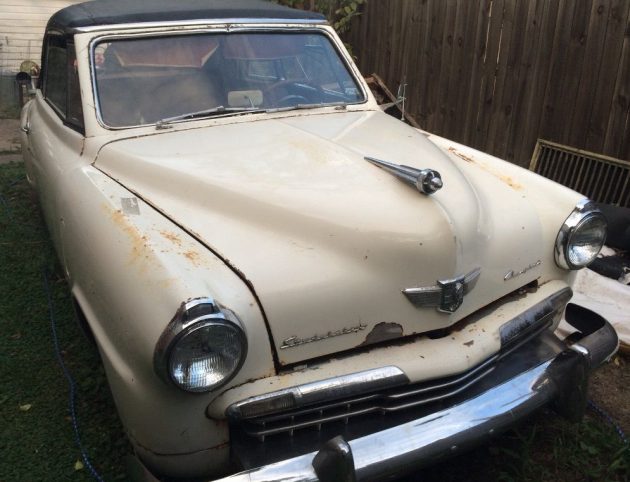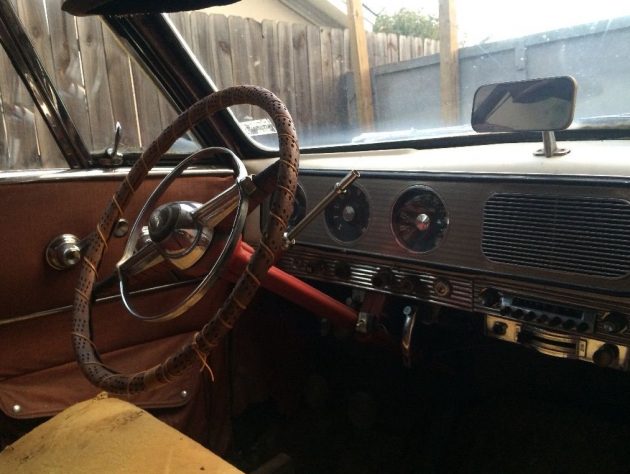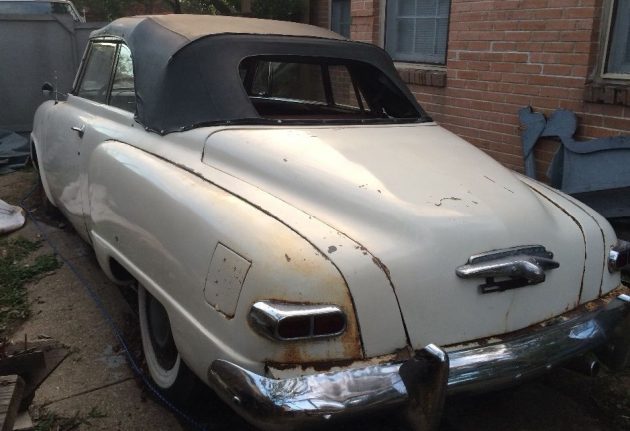The third generation Champion and the Commander were introduced in 1947. They were the first redesigned post war American cars, 2 years ahead of others. The design were completely new and very different from prewar cars. This convertible is listed on eBay in Dallas, Texas with a BIN of $8,500 and an opening bid of $5,000. There are no bids yet. It’s been stored for 35 years and is mostly complete.
The dash is really nice, but there are no pictures of the rest of the interior though, just 7 pictures of the dashboard and components as well as three of the sellers finger.
Here’s the 170 CID 80 HP engine. It looks complete but very rusty. There’s no word if it turns or not.
The top looks in really great condition for having sat for 35 years. Perhaps it’s been replaced recently. It’s possible a restoration was started, but this is as far as they got. There’s not a lot of rust visible, but being a convertible it’s likely very rusty underneath, after having been on the road for over 30 years. The bumpers and trim look to be in pretty good condition. If there is no serious rust what do you think this might be worth? What would it take to make it a driver? If it has major rust do you think it would be worth restoring?






I’ve always thought only Chrysler had dash mounted rear view mirrors.
Early corvettes too!
Most english cars such as Jaguars, always had dash mounted rear views.
Rolls Royce, Citroèn, and several other makes too.
I know very little about these, but I like what I see. This would be an interesting project and a fun car once done. I imagine this is a pretty rare find these days.
– John
He must have updated his ebay ad, there’s plenty of interior shots (Pretty rough) and only one of his finger…
“no pictures of the rest of the interior though, just 7 pictures of the dashboard and components…”
Plenty of interior shots? You must be looking at a different posting, I don’t see any pictures of the rest of the interior, as in front seat, back seat, floor, headliner, just the dash and door panels. Perhaps in the reflections of the dash? (And pictures one, seven and twelve include his finger.)
The rear bumper has aluminium tape on it so it must be rusted thru.
I was wrong sorry did not blow picture up enough dah
As a little tyke in the late fifties early sixties we had a lady who cleaned our house. She drove a ‘47,8,9 Stude two door I think. The one with the rear split window. I think thats a ’47. Anyway this looks like an interesting car to have and unless you go to a Stude meet you wont bump into a lot of other ones.
Its in Richard Rawlings hometown, guess he don’t wannit!
We can always hope!
The era of Postwar automobile manufacturing is a fascinating study. We learned new manufacturing techniques with new materials and we learned how to tool up fast. Morale was high and mom and dad started reproducing like bunnies. People wanted a departure from the slab sided underpowered behemoths that were old stodgy and stale. The manufacturers rushed to bring it ,and that enthusiasm and that desire to keep thing fresh continued right up til about 1970. Take the tri five Chevys for instance. The exterior design on these cars changed every year. Unheard of in today’s car market. Some models nowadays ,although they get some new plastic and badges ,stay unchanged for up to 7 years. Some longer. Please save this car. No one wants another war and that enthusiasm is once again beginning to flourish.
If only I had the budget to pick and choose, I would choose to save this, and it would just be too kool! Huge potential to be a great ride, love it.
Transverse front leaf spring like the fords had that attached to the lower a-arms.
Dash lights were a black light. Slow to get up and going but cool. Like your old Timex watch at night.
It does have a rare factory radio, but I am concerned with the steering wheel, having been covered with the faux leather wrapping. The reason I am concerned is there is no shift knob. The knob and the steering wheel use an early plastic rather than the Bakelite material that was commonly used. Years of extreme Texas heat would have been murder on the early plastics. Although this Champion is a little under-powered, they are a fair little road car on flat stretches and gas mileage was impressive considering the overall weight and size (170 CID) of the engine. This is one to either restore or keep as just a driveable Barn Find. Any Studebaker convertible is worth keeping close to original, being very low production.
MORE Scrap Iron. just a little less of it!
Just a friendly correction; Hudson had an all new body for 1948.
Automobile Driving Museum in LA has one they take out in their Sunday rotation to be driven in around the block – It is incredibly well put together in terms of fit and finish, engine smooth and quiet, and rides reasonably well. Oil filter was “optional” on the Champion so engine rebuilds at 60,000 miles was common.
I was born and raisd in So.Bend, In. so know all the Stude’s. I had a 48 2 dr Commander, and the ” Big 6 W/OD Commander ” was the one to have. Long legs, could keep up W/V-8. South Bend Police used these Champs, they’d get into sort of a high speed chase for 20 mi. and have to tow it back as the little 6 blew up. Studebaker was poorly managed, and along with the union, killed SP.
It was so poorly run that they had 2-3 people for 1 job and the “off” guys would hang out a window and smoke. The WWII Army trucks, the 50’s Commanders, and the Larks were grest. I had a 29 Dictator, and a 56 Power Hawk good cars.
Parts information are avaiilable at Studebaker Drivers Club.com
Hold out for a bulletnose (’50-’51) if u have the cash and patience!